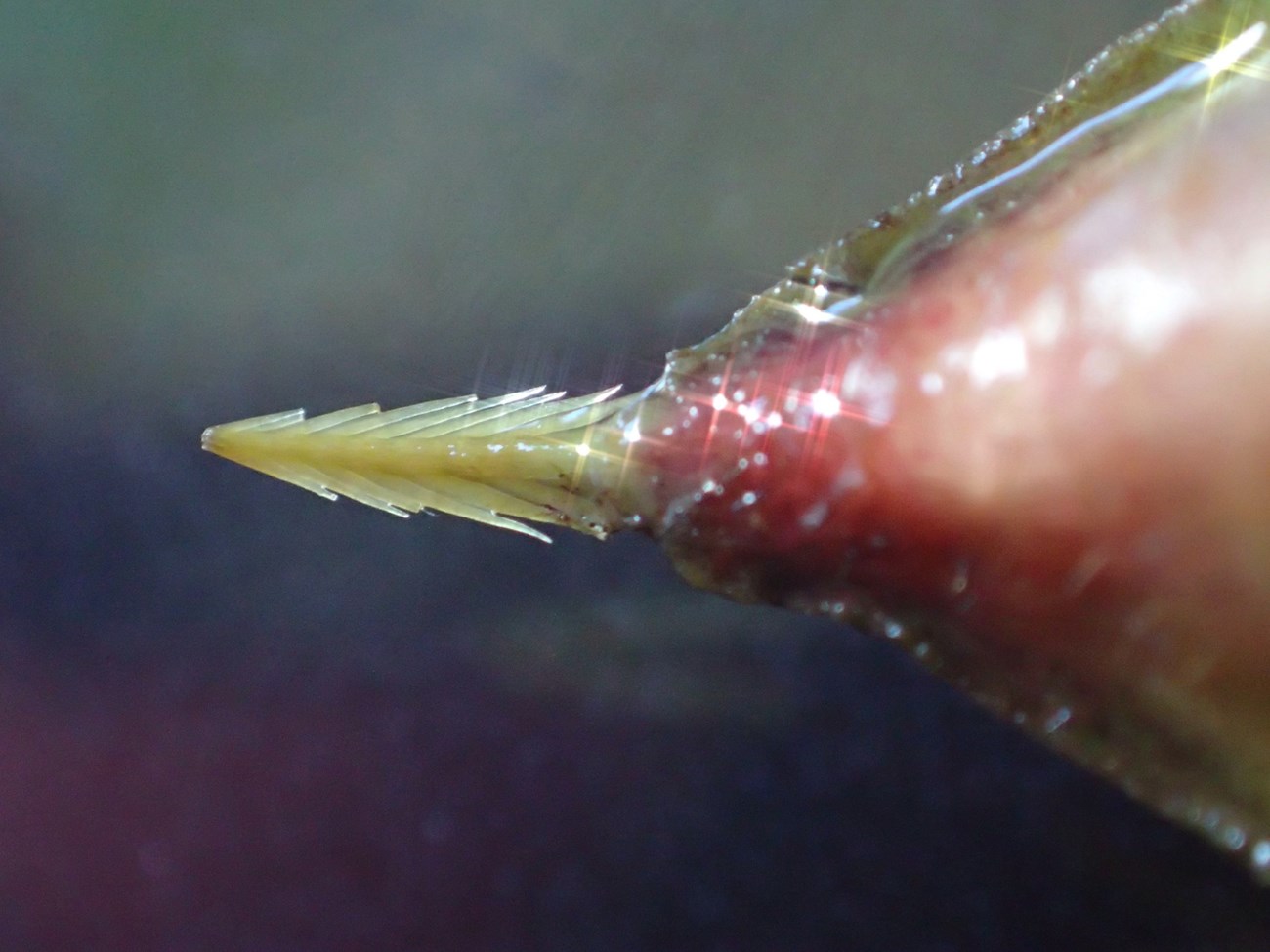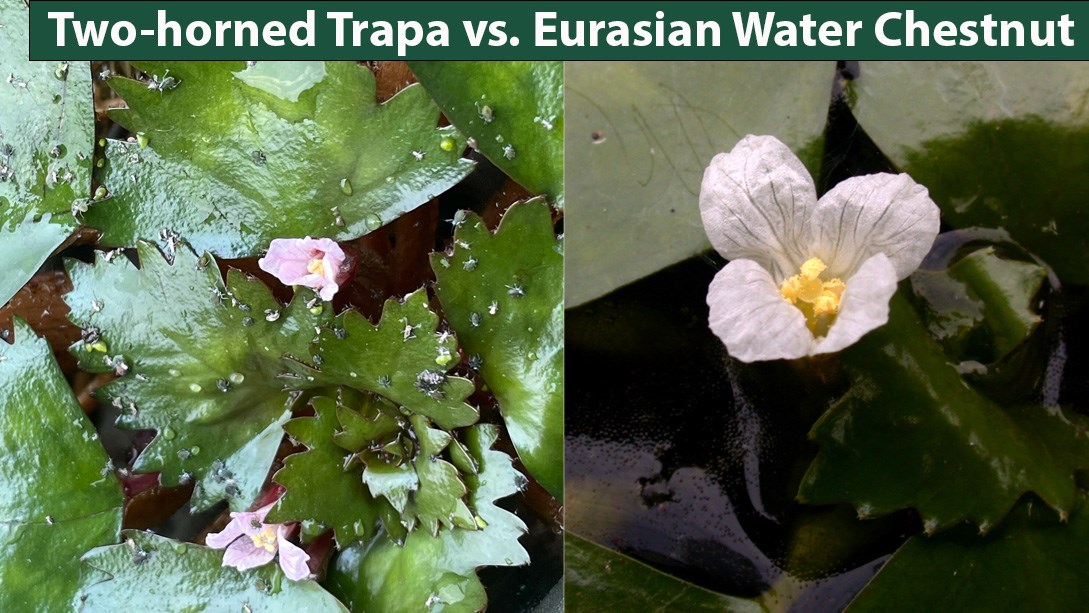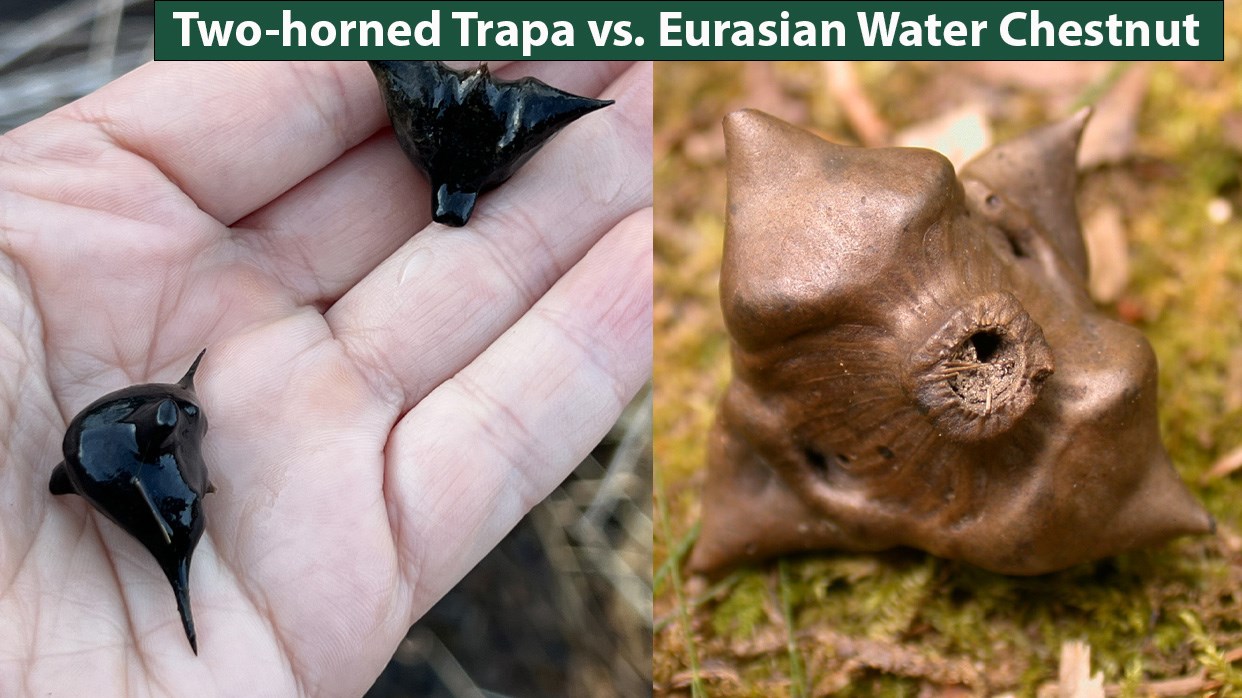Last updated: June 14, 2024
Article
Two-Horned Trapa (Trapa bispinosa)

Sara Tangren
If you’re enjoying the heat outdoors and want to stay cool by the water, watch out for this highly invasive water chestnut! Two-horned trapa (Trapa bispinosa) is an annual aquatic plant that was first reported in Pohick Bay in the freshwater tidal Potomac River near Lorton, VA in 2014 (Chorak et. al. 2019). Two-horned trapa can create a monoculture in aquatic habitats that will not only limit the recreational use of waterways and sunlight for native aquatic vegetation but also can limit the exchange of oxygen from the air into the water column.
The seed pod’s sharp, barbed “horns” attach to waterfowl, nets, wooden boats, and construction equipment and spread across or enter different waterbodies (Fairfax County, n.d., Swearingen & Fulton, pp. 35, 2022). On land, the seed pods can puncture through bicycle tires and shoes, creating hazards on roads. As of 2024, there are 130 observations in the United States on iNaturalist, all of which are in Maryland and Northern Virginia. Two-horned trapa is present in Virginia’s Fairfax, Fauquier, Prince William, and Loudoun Counties, and Maryland’s Prince George’s County, making it a local issue that we all need to be aware of.

Sara Tangren

Grant Reed (CC BY-NC)
Identification
Two-horned trapa is an annual aquatic plant found in freshwater habitats, typically in still to slow-moving water. In late May, leaves begin to emerge on the surface. The leaves are triangular, serrated, and formed into a rosette. The top surface of the leaf is green and reddish on the lower surface. The roots anchor into the mud up to 15ft deep, with the stem and a small portion of the leaf stems filled with air, allowing the plants to stay afloat (Rybicki, Swearingen, & Odenkirk 2019). In June, light pink flowers will emerge in the middle of the rosette and produce about two seed pods with two horns. Trapa dies back in the fall after a few frosts, typically in November. The seeds remain viable for at least two years.

Sara Tangren
Look-alikes
Two-horned trapa looks like another invasive water chestnut, Eurasian water chestnut (Trapa natans) enough to have likely been mistaken as Eurasian water chestnut prior to 2014 (Chorak et al., 2019). They both live in the same habitats and look similar on the surface. The key differences between two-horned trapa and Eurasian water chestnut will be the underside of the leaves, flowers, and seeds:
|
Features |
Two-horned trapa (Trapa bispinosa) |
Eurasian water chestnut (Trapa natans) |
|
Leaf |
Reddish lower surface |
Green lower surface |
|
Flower |
Light pink petals |
White petals |
|
Seed pods |
2 horns |
4 horns |

Left: Damien Ossi (CC BY-NC), iNaturalist. Right: Tatyana Kolesnikova (CC BY-NC), iNaturalist.

Left: johnbotany (CC BY-NC), iNaturalist. Right: François-Xavier Taxil (CC BY-NC), iNaturalist.

Left: Izabella Farr (CC BY-NC), iNaturalist. Right: François-Xavier Taxil (CC BY-NC); iNaturalist.
We need your help!
Writing about two-horned trapa is just a small piece of a larger pie. We depend on several ways to monitor this species, including citizen science through observation tracking. By downloading the iNaturalist app and joining the project, you'll be part of NatCap PRISM's fight against trapa and other Early Detective Rapid Response species!
How to Report two-horned trapa on iNaturalist:
- Take a picture of a floating rosette, both sides of the leaf if possible, the flower, and seeds if present
- Include a photo identifying the location and any distinguishing landmarks, like the edge of a path or a larger tree.
- In the notes section, tell us about the size of the infestation or the location.
- Once submitted, you can always edit your observation at any time
Tags
- antietam national battlefield
- catoctin mountain park
- chesapeake & ohio canal national historical park
- george washington memorial parkway
- harpers ferry national historical park
- manassas national battlefield park
- monocacy national battlefield
- national capital parks-east
- piscataway park
- prince william forest park
- rock creek park
- wolf trap national park for the performing arts
- invasive plant
- invasive species
- aquatic plants
- trapa bispinosa
- edrr
- early detection rapid response
- ncr
- nature
- ipmt
- water chestnut
